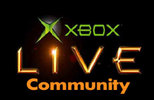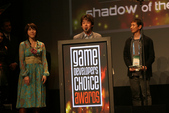
I’ve been to Game Developers Conference for seven years now. It’s always inspiring, thought provoking, and lots of fun. I’ve written up my thoughts on the last few years, and I’m back to do it again this year.
As always, sites like Gamasutra, GameSpot, and Next Generation have comprehensive coverage. What’s more, the full proceedings will be available online at GDCRadio.
They have me outnumbered, so I won’t try to compete with them on coverage or details. Consider this a high level, karmic overview, light on details and heavy on analysis.
Contents
- Goodbye Consoles, Hello Developers
- Social Networks and User Generated Content
- Microsoft’s Community Games
- Are Games Maturing?
Goodbye Consoles, Hello Developers
Like many businesses, a big part of game development is cyclical. Every five or six years sees a new generation of consoles, all usually launched within a year or so. The last generation started recently, with the XBox 360 released during the 2005 holiday season and the PS3 and the Wii in 2006. For that reason, Microsoft, Sony, and Nintendo were the loudest voices at the last couple GDCs.
The new consoles had settled in by this year’s GDC, though, so hardware took a back seat to software. Many of the most popular talks were given by the developers behind recent AAA next-gen titles, who discussed their techniques for developing on the new platforms. They included Ken Levine on delivering Bioshock’s story, Ubisoft on procedural data generation in Far Cry 2, and Kim Swift and Erik Wolpaw on user testing Portal, among others.
Social Networks and User Generated Content
Like last year, social networking and user-generated content reigned as the trendiest must-have game mechanics. Dozens of talks were devoted to them, from the production, business, and game design perspectives. They even took over established forums that weren’t devoted to them, including the Game Design Challenge and the Startup Showcase.
Also like last year, microtransactions came in a close second for trendiest game mechanic. “Free to play, pay for stuff” has become a rallying cry for casual games, smaller MMOs, international markets, and game mashups looking for a bandwagon. There’s even a promising startup that’s making microtransaction middleware, TwoFish, a sure sign that this trend has legs.

I have to admit, I consistently found myself dismissing these trends out of hand. I don’t use social networks much, I don’t often “generate content” outside of this site, and while I spend money on games, I don’t expect to buy a virtual shirt or sword or teddy bear any time soon. I was especially cynical about the startups in the Startup Showcase, since all of them were based on these trends. They reminded me, painfully, of the crazy business models in the dot com bubble.
After feeling that scorn well up in me a few times, I stopped and reconsidered. It didn’t matter that I wasn’t interested in social networking or user-generated content or microtransations. Lots of people are, and they’re speaking with their dollars. That’s what matters. Whenever I felt that scorn, I learned to take a few deep breaths, re-open my mind, and remind myself that I wasn’t the target audience.
Microsoft’s Community Games
Even if I am a 20th century dinosaur, I’m still incredibly excited about Microsoft’s XBox Live Community Games announcement. It removes the expensive, lengthy certification process required of current XBLA games and lets indie developers upload games directly to XBox Live.
Microsoft hinted about this last year, and I foamed at the mouth, but no one else paid much attention. I could say “I told you so,” but I’m more interested in actually trying it out. Honestly, I’m so excited that this writeup may be shorter than usual. I can’t wait to write an XBox 360 game on my laptop (!), upload it to Live, and make my friends try it out, all in the same day.
Sony, Nintendo, are you listening? That certification process for PSN and WiiWare is suddenly looking a little long in the tooth.
Are Games Maturing?
Apart from software and web 2.0 buzzwords, the main theme that emerged was a broad maturing across the industry. I don’t mean trading guns and girls for economics sims and Shakespeare, though; I mean maturing of the development process, business models, and game design. Even the awards ceremonies matured a little. This year, for the first time ever, the Developers Choice Awards were broadcast on national television.
Granted, the industry has been big for a while. “Games are bigger than the Hollywood box office” is quoted so often that it’s become a cliche. Just like people, though, new industries usually grow big well before they truly mature. While the game industry definitely isn’t fully matured yet, if this GDC was any indication, it’s definitely on its way.
Project Management
In the last few years, development best practices have been sure bets for GDC topics. Agile and scrum, continuous builds, automated regression testing, and eating dogfood always claim at least a few talks each. Admittedly, they’re called best practices for a reason…but still, these talks have always felt a bit like frenzied sales pitches on late night infomercials.
This year, though, there was a distinct difference. Most of these practices were discussed as matters of course, not as sales pitches. Established developers such as Ubisoft, Blizzard, and NetDevil mentioned them in passing, almost as accepted norms. The talks devoted to them felt more confident, offering upbeat postmortems on their experiences and advice on how to implement these practices in real world situations.
Game Design
Project management wasn’t the only aspect of the industry that seemed to be maturing. Many developers also discussed the best practices they’d adopted in their design processes. Highlights included iterative design, rapid prototyping, and user testing.
One of the most popular talks of the conference, a postmortem on Game of the Year Portal, happily acknowledged its debt to extensive prototyping and user testing. Designers from Blizzard, Bungie, and Ubisoft all mentioned similar debts in their latest titles.
Beyond best practices, I was intrigued to hear how designers were attempting to quantify and measure aspects of game design such as immersion, balance, perception, and even community. Clint Hocking’s talk on immersive fidelity was fascinating, as were Rob Pardo on balancing multiplayer games, Sulka Haro on learning from Habbo Hotel’s users, CCP on hiring architects and fashion designers for EVE Online, and Bungie on designing AI, not programming it.
Lastly, the Game Designers Rant delved into serious and real-world games, a couple of the most interesting and unusual trends in game design recently.
Business
As opposed to game development and design, the business of games has already matured in many respects. Still, a number of talks revealed encouraging new trends in business as well.
Independent game development studios have been dealing with entrepreneurship issues for decades, long before the term startup came into vogue. Still, there was much more collaboration with seasoned entrepreneurs and venture capitalists this year. VC fund CRV sponsored the Startup Showcase, along with other sessions. I also regularly overheard the startup lingo of term sheets, exit strategies, and valuations on the expo floor.
Larger companies also seemed to be maturing. A number of talks discussed HR challenges such as quality of life in the wake of the EA_Spouse fallout. Elsewhere, talks like Cryptic’s addressed common IT challenges raised by MMOGs, user-generated content, and digital distribution. Many discussed standard, off-the-shelf solutions, which was especially surprising given the egotistical, not-invented-here culture of many game developers.
For me, the clearest sign of the times came from Matt Hooper, a producer at id, who acknowledged the value of management ideas widely accepted by modern publishers and even other industries. id’s not known for their business innovation, so if they’re pulling their head out of the sand, that’s a sign.
As always, this year’s conference came to an end all too quickly. Congratulations to Portal, Crayon Physics, and the rest of the other award winners. To everyone I talked with, it was great to catch up! See you all next year…







one of the more interesting announcements i didn’t catch at GDC was Insomniac‘s Nocturnal Initiative. basically, they’re releasing a bunch of their internal libraries as open source. cool!
traditional game developers have slow to embrace open source, especially when it comes to their own code. japanese game developers in particular were famously secretive with their “trade secrets” and technology in the past. they went go to great lengths to protect it from competitors. today, developers aren’t nearly as protective, but they’re still much more likely to offer their own technology as commercial middleware than to open source it.
happily, it looks like that culture is changing now. indie game developers have been championing open source for a while, and now Insomniac is too!